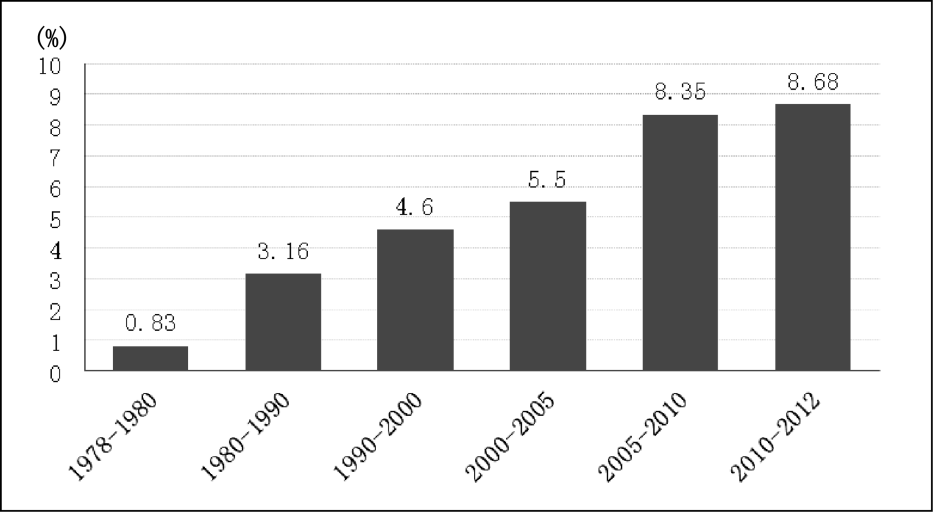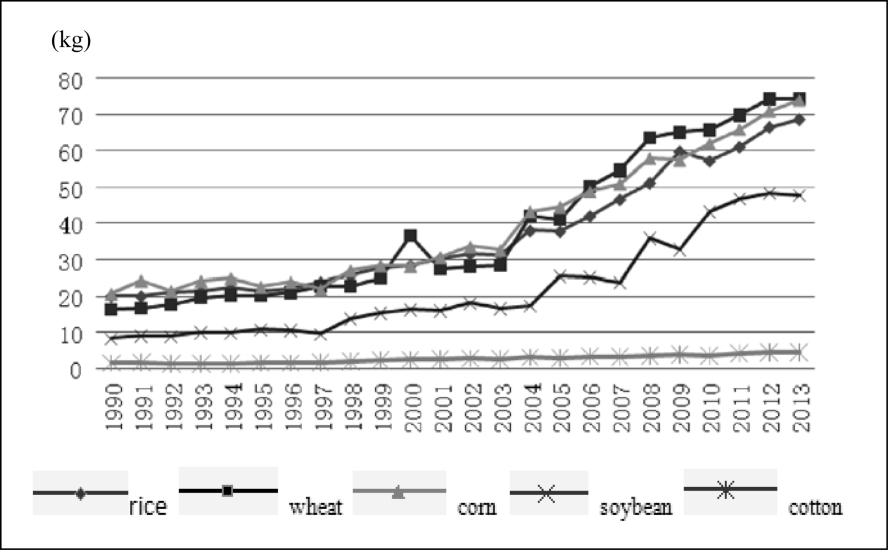Improvement of Labor Productivity: Key to Agricultural Modernization
Oct 12,2015
By Ye Xingqing, Research Department of Rural Economy of DRC
Research Report Vol.17 No.5, 2015
In the process of synchronously promoting a new type of industrialization, informatization, urbanization and agricultural modernization, the weak link is agricultural modernization. To realize agricultural modernization, the stumbling stones are small-scale operation and low labor productivity, which leads to long-standing high cost of agricultural production and declining agricultural competitiveness. As a result, it is difficult for farmers to have an income comparable with the average of the whole society, and the Kuznets effect , supposed to show presence when labor is reallocated, weakens its contribution in economic growth too early. With a large size of population and a small amount of land as well as the urban-rural dual system, special difficulties abound in improving agricultural labor productivity in China. During the 13th Five-year Plan period, the Chinese government should be committed to promoting moderate-scale agricultural operation and improving agricultural labor productivity, which should be regarded as the key to accelerating agricultural modernization in China.
I. Low Labor Productivity Impedes Agricultural Development in China
After years of efforts, remarkable achievements have been chalked up in Chinese agricultural modernization. In 2014, agricultural technology in China contributed 56% to agricultural modernization, 61% of agricultural plowing, planting and harvesting was achieved by mechanized farming, over 51% of farmland was effectively irrigated, over 95% of farm crops were improved varieties, and the average commodity rate of three crops was more than 86% . Chinese agriculture has witnessed more improved varieties of crops, better utilization of water resources for agricultural production, greater rate of mechanized farming and higher commodity rate of crops, all of which are beyond comparison with traditional agriculture. Generally speaking, China has entered into the middle-to-late stage of agricultural modernization (see Table 1).
Table 1 Different Stages of Agricultural Modernization
|
Key indicators |
Stages of traditional agriculture (1) |
Stages of agricultural modernization |
Post agricultural modernization (5) |
Actual value of China in 2014 | ||
|
Prelimi-nary stage (2) |
Middle stage (3) |
Late stage (4) | ||||
|
The proportion of agriculture in GDP |
>50% |
20%―50% |
10%―20% |
5%―10% |
<5% |
9.2% |
|
The proportion of agricultural employment in the overall employment |
>80% |
50%―80% |
20%―50% |
6%―20% |
<6% |
29.5% |
|
The contribution rate of agricultural technology |
<5% |
5%―30% |
30%―60% |
60%―80% |
>80% |
56% |
|
The rate of mechanized farming |
<5% |
5%―30% |
30%―60% |
60%―80% |
>80% |
61% |
|
The rate of agricultural intermediate consumption |
<10% |
10%―20% |
20%―40% |
40%―50% |
>50% |
40.7% |
Note: Based on the research by Jiang Heping and Huang Delin (2006), the division of the stages of agricultural modernization is modified and finalized by the author. With the transfer of surplus agricultural labor force and the improvement of agricultural mechanization, agricultural labor productivity greatly rises.
The annual average of overall labor productivity in agriculture is steadily increasing (see Figure 1). Due to the smaller amount of labor used per mu (0.0667 hectares) and increased yield per mu, agricultural labor productivity, based on the actual amount of labor used and the actual yield, rises at a quicker pace. According to the national cost-benefit analysis of agricultural products, from 1990 to 2013, among major agricultural products produced per working day, rice had an annual growth rate of 9.9%, wheat 12.3%, corn 10.3%, soybean 14.3%, and cotton 8.7% (see Figure 2).
Figure 1 Annual Average Growth of Overall Labor Productivity in Agriculture

However compared with advanced economies, agricultural sectors in China march at different paces towards agricultural modernization, with crop yields close to or even exceeding the advanced level in the world, while the proportion of agricultural employment and agricultural labor productivity are far below the advanced level in the world, and thus leading to an unbalanced development. Based on “China Modernization Report 2012: A Study on Agricultural Modernization” released by China Center for Modernization Research, Chinese Academy of Sciences, though rice, wheat and corn yield in China reached the level of moderately developed countries, agriculture labor productivity is some 47% of the world’s average, only 2% of the average level of high-income countries, and 1% of that in the United States, which is unfavorable to not only agricultural development but also overall economic growth in China.
Figure 2 Average Yield of Major Agricultural Products per Working Day

First, low agricultural labor productivity makes prices of Chinese agricultural products less competitive. Since China’s accession to the WTO in 2001, costs and prices of Chinese bulk agricultural products, like grain, are still competitive despite the low price of agricultural labor force and low agricultural labor productivity. As the transfer of China’s agricultural labor reaches the Lewis turning point, although agricultural production requires less labor, wages of migrant workers rise dramatically, which drives up the labor cost of agricultural production, as a result, causing a rapid increase of labor cost in agricultural production. From 2008 to 2013, the total cost of the three crops per mu had an average annual growth of 12.78%, among which 19.68% of the cost increase was attributed to the rise of the annual average labor cost per mu. At present, prices of China’s main agricultural products are higher than the after-tax C.I.F. prices of imported agricultural products, and the rise of domestic prices are severely restricted. This can be attributed to, on the one hand, the falling price of international agricultural products. But on the other hand, the root cause is that the cost, especially labor cost, of agricultural products at home is much higher than that in other countries. In 2013, the total cost of rice, wheat, corn, soybeans, peanuts, and cotton per 50 kg in China was 40% to 80% higher than that in the United States. In particular, labor in China costs 6 to 20 times that in the United States; land in China costs 10% to 170% higher than that in the United States; and materials and services in China cost 5% to 55% less than that in the United States (see table 2). High cost of production, especially the high labor cost, is why prices of agricultural products in China are less competitive than those in the United States.
Table 2 Cost of Main Agricultural Products in China and the United States in 2013
|
|
Total cost per 50 kg (yuan) | ||
|
China |
The United States |
Cost in China is higher than that in the US by (%) | |
|
Rice |
122.02 |
87.50 |
39.46 |
|
Wheat |
122.18 |
91.20 |
33.98 |
|
Corn |
83.51 |
52.53 |
58.98 |
|
Soybean |
226.71 |
123.72 |
83.24 |
|
Peanut |
263.20 |
169.00 |
55.74 |
|
Cotton |
1233.85 |
811.36 |
52.07 |
|
|
Labor cost per 50 kg (yuan) | ||
|
China |
The United States |
Cost in China is higher than that in the US by (%) | |
|
Rice |
51.87 |
6.20 |
737.11 |
|
Wheat |
45.92 |
5.72 |
702.95 |
|
Corn |
46.66 |
2.14 |
2084.71 |
|
Soybean |
72.79 |
5.44 |
1237.67 |
|
Peanut |
128.99 |
16.69 |
673.11 |
|
Cotton |
770.53 |
50.76 |
1418.06 |
|
|
Land cost per 50 kg (yuan) | ||
|
China |
The United States |
Cost in China is higher than that in the US by (%) | |
|
Rice |
20.49 |
18.16 |
12.82 |
|
Wheat |
20.55 |
18.62 |
10.36 |
|
Corn |
20.18 |
13.02 |
55.01 |
|
Soybean |
79.93 |
40.76 |
96.10 |
|
Peanut |
44.31 |
16.35 |
171.08 |
|
Cotton |
142.97 |
99.85 |
43.18 |
|
|
Material cost per 50 kg (yuan) | ||
|
China |
The United States |
Cost in China is higher than that in the US by (%) | |
|
Rice |
49.67 |
63.14 |
-21.34 |
|
wheat |
55.71 |
66.86 |
-16.67 |
|
Corn |
16.67 |
37.38 |
-55.39 |
|
Soybean |
73.99 |
77.52 |
-4.56 |
|
Peanut |
89.89 |
135.97 |
-33.89 |
|
Cotton |
320.35 |
660.75 |
-51.52 |
Source: Compilation of Documents on Cost-benefit Analysis of China’s Agricultural Products (2014).
…
If you need the full text, please leave a message on the website.














